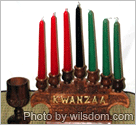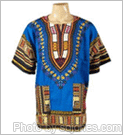Kwanzaa, just like any other holiday, has a variety of symbols that go along with it. These symbols help to define the holiday, and each has a specific purpose or significance. Following is a list of some symbols of Kwanzaa and how they came to be associated with the holiday.

Kinara
The kinara is a candle holder that carries seven candles. The candles represent the Seven Principles of Kwanzaa: unity, self-determination, collective work and responsibility, cooperative economics, purpose, creativity, and faith. Usually, each night of the holiday, a child is given the responsibility of lighting one of the candles of the kinara. Once the candle is lit, the family gathers to discuss one of the Seven Principles.
Other Symbols
There are six other symbols that, in addition to the kinara, are key parts of the celebration of Kwanzaa. They are:
- Mazao (The Crops) - A bowl or other arrangement of fruit that symbolizes the African harvest as well as the rewards of collective labor.
- Mkeka (The Mat) - A floor mat that symbolizes the foundation of African tradition and history.
- Muhindi (The Corn) - Ears of corn that represent children and their embodiment of the future.
- Mishumaa Saba (The Seven Candles) - These are the candles that are placed into the kinara. They represent the nguza saba, the Seven Principles of Kwanzaa.
- Kikombe cha Umoja (The Unity Cup) - This cup is a symbol of the unity of the people, from which anything is possible.
- Zawadi (The Gifts) - Gifts given from parents to their children during Kwanzaa, as a reminder of their love for them as well as commitments made and kept by the children.

Traditional Clothing
The purpose of Kwanzaa is to allow African Americans to honor their African roots and reconnect with their heritage. A big part of that heritage is uniquely African clothing. So, during Kwanzaa, it's customary to wear traditional African garb as part of the celebration.
Men usually wear dashikis, a colorful garment that covers the upper body, and kufis, which are short, brimless hats. Women usually wear pull-over robes called kaftans. Also called boubous, kaftans can be either formal or informal.
These symbols act as a reminder to African Americans of the culture and community in which they find their roots. Anyone can apply this lesson to their lives by honoring their own heritage during the celebration of Kwanzaa.